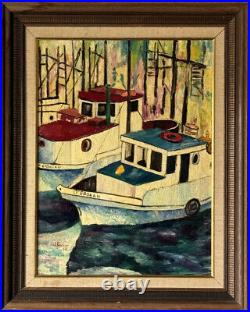
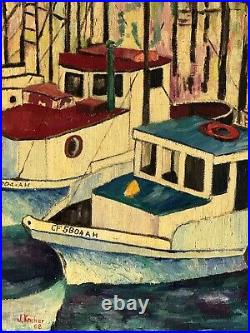
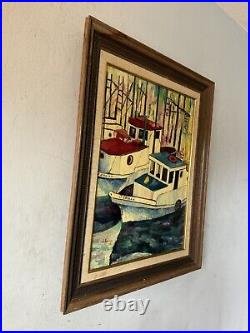

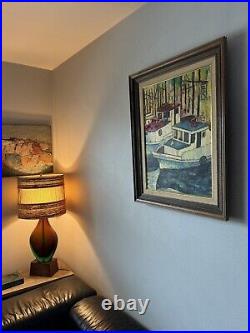
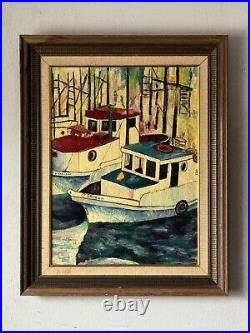
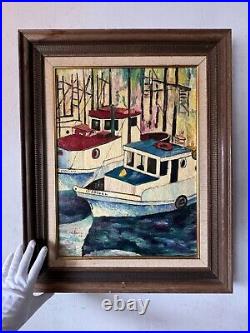
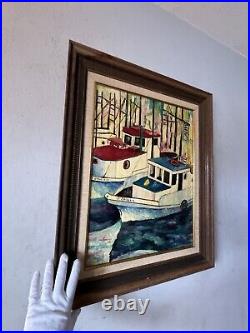
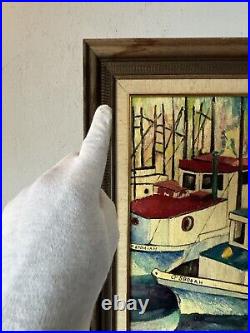
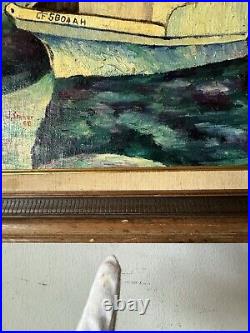
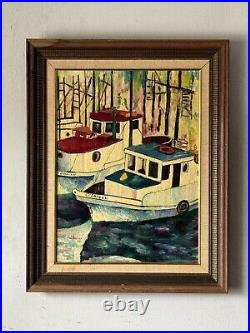
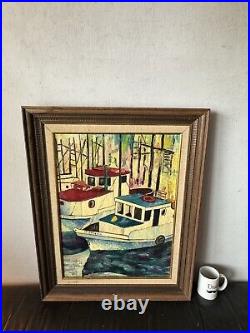
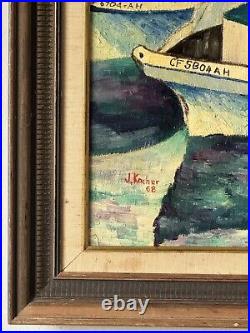
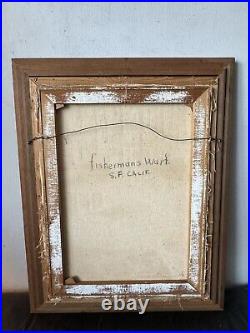
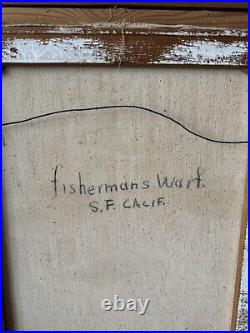
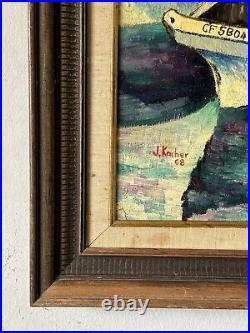

COOL VINTAGE MID-CENTURY MODERN CALIFORNIA IMPRESSIONIST OIL PAINTING ON CANVAS. THIS WORK DEPICTS A BEAUTIFUL AND VIBRANT BOAT SCENE IN FISHERMAN’S WHARF, AN ICONIC LANDMARK LOCATED IN SAN FRANCISCO CALIFORNIA. IT IS SIGNED AND DATED 1968. PERHAPS YOU RECOGNIZE THE ARTIST? MILD WEAR TO THE FRAME AS SHOWN. DIMENSIONS: 30″ H x 24″ W. Fisherman’s Wharf, on the northern waterfront, is one of the city’s busiest tourist areas. At Ghirardelli Square, boutiques and eateries reside in the famed former chocolate factory. One of the great pleasures of visiting San Francisco is a stroll along this city’s historic Fisherman’s Wharf. Here, visitors can peer down at the fishing crafts riding in the calm water or pause to watch fishermen mending a net. Most boats in view belong to a “third generation” fishing craft, which has made history at Fisherman’s Wharf. From the days of the Gold Rush until the turn of the century, the San Francisco fishing fleet comprised lateen-rigged sailboats. They were copies of the craft the Italian fishermen knew in their native land. Green was the prevailing color of the tiny boats, and the name of a patron saint appeared on the hull. The fishermen themselves were as colorful as their craft. Their natural talent for song was to be heard in renditions of arias from Verdi, lusty if not always faithful to the ear. In the fog-shrouded waters outside the Golden Gate, the singing was a means of communication. You could not see a companion boat, but you knew it was there. The “second generation” of fishing boats came with the introduction of gasoline engines, small but dependable “put-puts”. What became known as the Monterey Hull boats came into general use. The gas engine made it possible to fish more days of the year, gave a more comprehensive range for their operation in the ocean water, and provided power to haul in the nets or lines. Even today, several hundred of the Monterey-type boats remain as a part of the fishing fleet. Often likened to the “vintage” automobiles of the Model-T era, the Monterey Hull craft ride at harbor alongside a “‘third generation” of commercial fishing boats, diesel-powered craft that overshadow them in size cruising capacity and are often equipped with two-way radio telephones and “sonar” depth-finders. Fishermen used to get news about the weather from nature instead of a radio or television report. If the moon was in the east, the tide was coming in, or if in the west, the tide was flowing out the Golden Gate. A circle around the moon meant rain. Porpoises playing around the boat indicated a stormy wind was brewing. Old timers around Fisherman’s Wharf have other tales to tell, recalled from the period of the last sailboats. It was hard work. If the boat was becalmed, they waited long hours for a breeze or got out the oars and rowed. Sometimes, they would throw a grappling hook into the rudder chain of a passing steamer and get an easy ride home. When the steamer crews called out imprecations against these marine hitchhikers, the Italian fishermen screamed right back in words that soon became a part of waterfront lingo. In those earlier periods, the favorite fishing spots were outside the Golden Gate, just beyond the waves breaking on the rocks and sandy beaches. It took great skill to manage the boats so they did not drift ashore and be wrecked. Today, as in the past, it is the fishing fleet, operated by the grandsons and great-grandsons of these past generations, which makes Fisherman’s Wharf a place of activity, the center of an ocean-oriented industry beloved by native San Franciscans and visitors alike. History Lives On At Fisherman’s Wharf. San Francisco’s Fisherman’s Wharf is proudly unique among the scenic waterfront attractions of the world. The Fisherman’s Wharf of today rests on land created from the rubble of buildings destroyed in the earthquake and fire of 1906. What could not be destroyed was the love of the sea, generations of fishing skills, and traditions expressed in good things to eat and drink. Many of the well-known sights of today were developed only in the last few decades. The original Meigg’s Wharf was once the main port of entry to San Francisco and an extremely industrious place. Hardworking fishermen, both Chinese and Italian (who were often accompanied by their wives), set out to make a living by catching fish and crab in small vessels at the wharf. It is the heritage of these early fishermen, that contributes to today’s color blending of the old and the new at Fisherman’s Wharf – the center of an ocean-oriented industry beloved by native San Franciscans and visitors alike. Today, as in the past, it is the fishing fleet that gives Fisherman’s Wharf its authenticity and activity.

